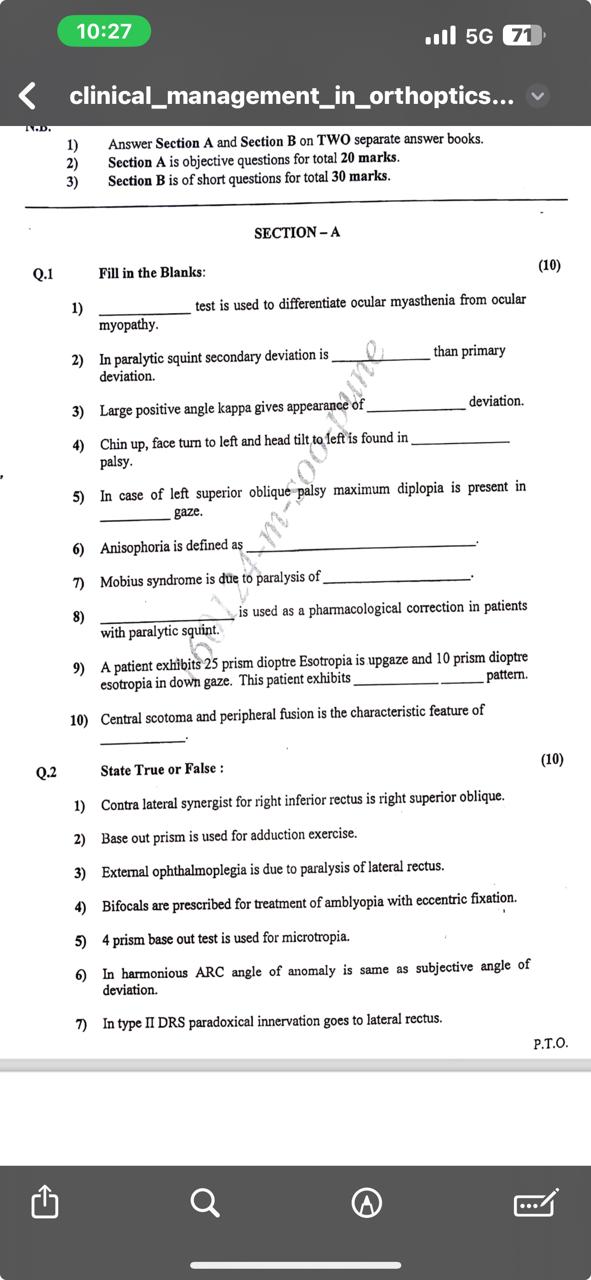Fill in the Blanks: 1) ____________ test is used to differentiate ocular myasthenia from ocular myopathy. 2) In paralytic squint, secondary deviation is ____________ than primary d... Fill in the Blanks: 1) ____________ test is used to differentiate ocular myasthenia from ocular myopathy. 2) In paralytic squint, secondary deviation is ____________ than primary deviation. 3) Large positive angle kappa gives appearance of ____________ deviation. 4) Chin up, face turn to left and head tilt to left is found in ____________ palsy. 5) In case of left superior oblique palsy, maximum diplopia is present in ____________ gaze. 6) Anisophoria is defined as __________________________. 7) Mobius syndrome is due to paralysis of __________________________. 8) ____________ is used as a pharmacological correction in patients with paralytic squint. 9) A patient exhibits 25 prism dioptre Esotropia is upgaze and 10 prism dioptre esotropia in downgaze. This patient exhibits ________________________ pattern. 10) Central scotoma and peripheral fusion is the characteristic feature of ____________. State True or False: 1) Contra lateral synergist for right inferior rectus is right superior oblique. 2) Base out prism is used for adduction exercise. 3) External ophthalmoplegia is due to paralysis of lateral rectus. 4) Bifocals are prescribed for treatment of amblyopia with eccentric fixation. 5) 4 prism base out test is used for microtropia. 6) In harmonious ARC angle of anomaly is same as subjective angle of deviation. 7) In type II DRS paradoxical innervation goes to lateral rectus.

Understand the Problem
The question is asking for specific terminology and definitions related to clinical management in orthoptics, particularly about ocular conditions and treatments. It involves filling in blanks and stating if certain statements are true or false based on medical knowledge.
Answer
1) Tensilon. 2) greater. 3) outward. 4) right superior oblique. 5) downward. 6) difference in phoria. 7) facial and abducens nerves. 8) Botulinum toxin. 9) A-pattern. 10) microtropia. True or False: 1) False. 2) True. 3) False. 4) False. 5) True. 6) True. 7) False.
- Tensilon test is used to differentiate ocular myasthenia from ocular myopathy. 2) In paralytic squint, secondary deviation is greater than primary deviation. 3) Large positive angle kappa gives appearance of outward deviation. 4) Chin up, face turn to left and head tilt to left is found in right superior oblique palsy. 5) In case of left superior oblique palsy, maximum diplopia is present in downward gaze. 6) Anisophoria is defined as a difference in the amount of phoria between different gaze positions. 7) Mobius syndrome is due to paralysis of the facial and abducens nerves. 8) Botulinum toxin is used as a pharmacological correction in patients with paralytic squint. 9) A patient exhibits 25 prism dioptre esotropia in upgaze and 10 prism dioptre esotropia in downgaze. This patient exhibits an A-pattern. 10) Central scotoma and peripheral fusion is the characteristic feature of microtropia. True or False: 1) False. 2) True. 3) False. 4) False. 5) True. 6) True. 7) False.
Answer for screen readers
- Tensilon test is used to differentiate ocular myasthenia from ocular myopathy. 2) In paralytic squint, secondary deviation is greater than primary deviation. 3) Large positive angle kappa gives appearance of outward deviation. 4) Chin up, face turn to left and head tilt to left is found in right superior oblique palsy. 5) In case of left superior oblique palsy, maximum diplopia is present in downward gaze. 6) Anisophoria is defined as a difference in the amount of phoria between different gaze positions. 7) Mobius syndrome is due to paralysis of the facial and abducens nerves. 8) Botulinum toxin is used as a pharmacological correction in patients with paralytic squint. 9) A patient exhibits 25 prism dioptre esotropia in upgaze and 10 prism dioptre esotropia in downgaze. This patient exhibits an A-pattern. 10) Central scotoma and peripheral fusion is the characteristic feature of microtropia. True or False: 1) False. 2) True. 3) False. 4) False. 5) True. 6) True. 7) False.
More Information
The Tensilon test involves the injection of edrophonium chloride to temporarily improve muscle strength in individuals suspected of having myasthenia gravis. The use of prisms in orthoptics helps manage eye alignment disorders like strabismus.
Tips
Be sure to understand the difference between primary and secondary deviation in paralytic squint to avoid confusion.
Sources
- Video-Oculography for the Diagnosis of Ocular Myasthenia Gravis - ncbi.nlm.nih.gov
- Ocular Myasthenia Gravis - Brigham and Women's Hospital - brighamandwomens.org
- Strabismus (Squint) | Ento Key - entokey.com